Let you understand the reasons and solutions for MySQL startup failure
This article brings you relevant knowledge about mysql, which mainly introduces related issues about mysql startup failure, including the reasons for startup failure and solutions, etc., which may be due to lack of My.ini file, lack of data files, port occupation and other issues, let's take a look at them together. I hope it will be helpful to everyone.

Recommended learning: mysql video tutorial
My computer here is win10 and mysql is version 8.0.
Generally, when installing MySQL through a compressed installation package, MySQL may fail to start, as shown below: 
Based on various information on the Internet and your own actual operations, summarize For the following three reasons:
1. Lack of my.ini file
Create the my.ini file through Notepad. You can also search for other my.ini files on your computer. After copying it, modify it (make sure it is in the format of the configuration file).
After creating the my.ini file, save it to the sever directory, as shown below:
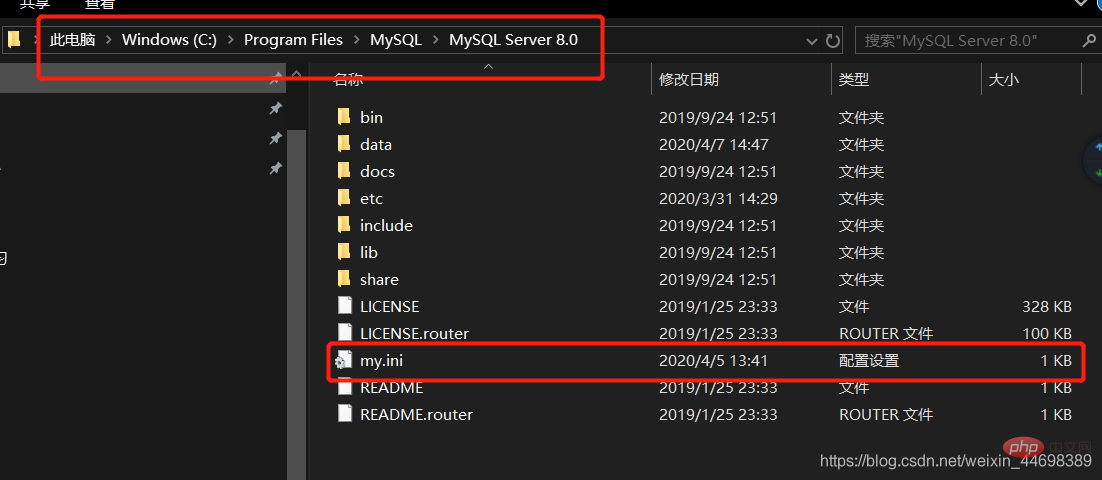
2. Lack of data file
When there is a lack of data files, be careful not to create data files manually! ! ! Manually creating the data file will still fail to start.
Operation method:
(1) Run the command control character (cmd) as administrator
Attention! ! ! If you do not run as an administrator at this time, errors may occur.
(2) Enter
mysqld --initialize --user=mysql --console
in cmd and 
will appear. Remember the temporary password at this time, you will use it later.
Notice! ! !
If the command line is mysqld --initialize-insecure without adding –console, when logging in to mysql, just click enter to enter. The password at this time is an empty password, but a password will be generated later, which we cannot see. Yes, I won’t be able to log in to mysql next time. (Wrong password)
(3) Run mysql

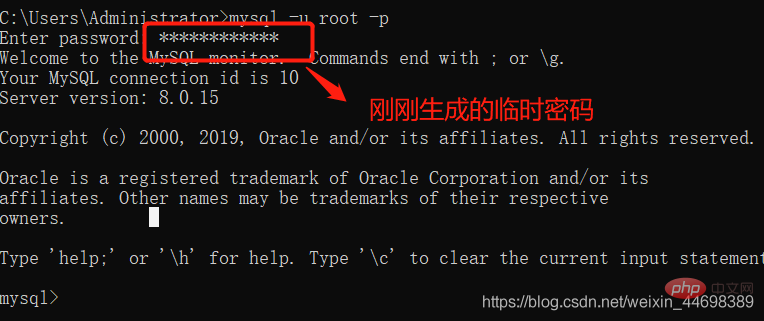
(4) Change the password and enter ALTER USER 'root'@' localhost' IDENTIFIED WITH mysql_native_password BY 'new password';
ALTER USER 'root'@'localhost' IDENTIFIED WITH mysql_native_password BY '123456';
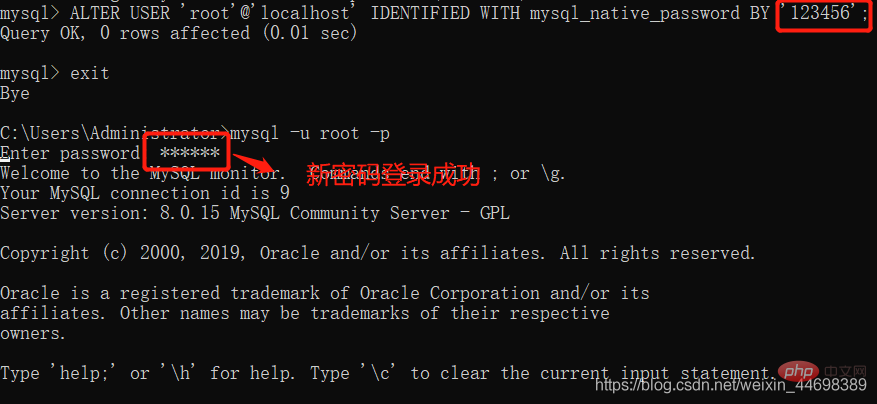
3. Port occupation (MySQL's default port is 3306)
You can view it here .err file under data to check whether there is any port occupation.
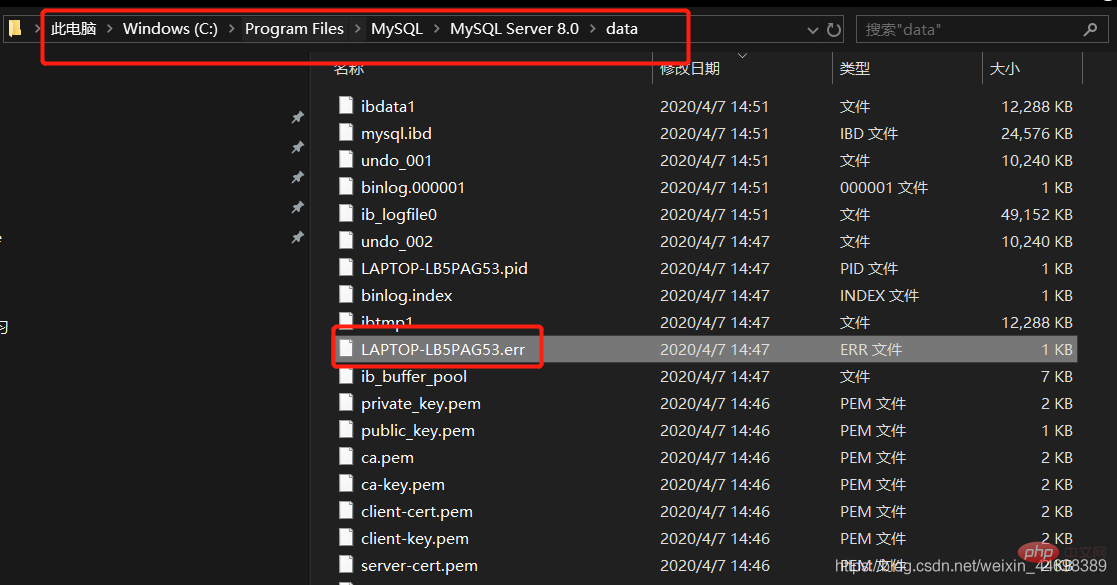
If the port is occupied, you can check which process occupies port 3306 by entering the following command on the command line.
netstat -ano

Find the PID occupying port 3306, as shown below: 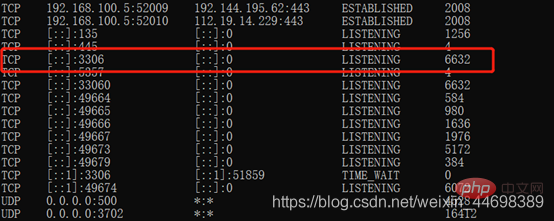
Go to Task Manager to close the process corresponding to the corresponding PID. 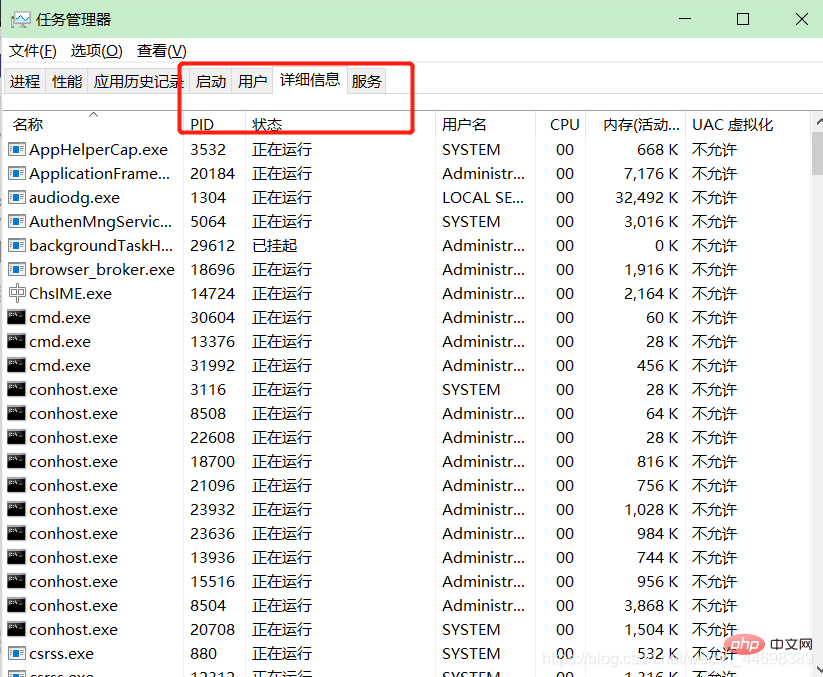
The problem is successfully solved at this time! ! !
During the process of running mysql, other errors may also occur. The corresponding reasons can be obtained by checking the .err file in the data.
Recommended learning: mysql video tutorial
The above is the detailed content of Let you understand the reasons and solutions for MySQL startup failure. For more information, please follow other related articles on the PHP Chinese website!

Hot AI Tools

Undresser.AI Undress
AI-powered app for creating realistic nude photos

AI Clothes Remover
Online AI tool for removing clothes from photos.

Undress AI Tool
Undress images for free

Clothoff.io
AI clothes remover

Video Face Swap
Swap faces in any video effortlessly with our completely free AI face swap tool!

Hot Article

Hot Tools

Notepad++7.3.1
Easy-to-use and free code editor

SublimeText3 Chinese version
Chinese version, very easy to use

Zend Studio 13.0.1
Powerful PHP integrated development environment

Dreamweaver CS6
Visual web development tools

SublimeText3 Mac version
God-level code editing software (SublimeText3)

Hot Topics
 How to connect to the database of apache
Apr 13, 2025 pm 01:03 PM
How to connect to the database of apache
Apr 13, 2025 pm 01:03 PM
Apache connects to a database requires the following steps: Install the database driver. Configure the web.xml file to create a connection pool. Create a JDBC data source and specify the connection settings. Use the JDBC API to access the database from Java code, including getting connections, creating statements, binding parameters, executing queries or updates, and processing results.
 MySQL: An Introduction to the World's Most Popular Database
Apr 12, 2025 am 12:18 AM
MySQL: An Introduction to the World's Most Popular Database
Apr 12, 2025 am 12:18 AM
MySQL is an open source relational database management system, mainly used to store and retrieve data quickly and reliably. Its working principle includes client requests, query resolution, execution of queries and return results. Examples of usage include creating tables, inserting and querying data, and advanced features such as JOIN operations. Common errors involve SQL syntax, data types, and permissions, and optimization suggestions include the use of indexes, optimized queries, and partitioning of tables.
 MySQL's Place: Databases and Programming
Apr 13, 2025 am 12:18 AM
MySQL's Place: Databases and Programming
Apr 13, 2025 am 12:18 AM
MySQL's position in databases and programming is very important. It is an open source relational database management system that is widely used in various application scenarios. 1) MySQL provides efficient data storage, organization and retrieval functions, supporting Web, mobile and enterprise-level systems. 2) It uses a client-server architecture, supports multiple storage engines and index optimization. 3) Basic usages include creating tables and inserting data, and advanced usages involve multi-table JOINs and complex queries. 4) Frequently asked questions such as SQL syntax errors and performance issues can be debugged through the EXPLAIN command and slow query log. 5) Performance optimization methods include rational use of indexes, optimized query and use of caches. Best practices include using transactions and PreparedStatemen
 Why Use MySQL? Benefits and Advantages
Apr 12, 2025 am 12:17 AM
Why Use MySQL? Benefits and Advantages
Apr 12, 2025 am 12:17 AM
MySQL is chosen for its performance, reliability, ease of use, and community support. 1.MySQL provides efficient data storage and retrieval functions, supporting multiple data types and advanced query operations. 2. Adopt client-server architecture and multiple storage engines to support transaction and query optimization. 3. Easy to use, supports a variety of operating systems and programming languages. 4. Have strong community support and provide rich resources and solutions.
 MySQL's Role: Databases in Web Applications
Apr 17, 2025 am 12:23 AM
MySQL's Role: Databases in Web Applications
Apr 17, 2025 am 12:23 AM
The main role of MySQL in web applications is to store and manage data. 1.MySQL efficiently processes user information, product catalogs, transaction records and other data. 2. Through SQL query, developers can extract information from the database to generate dynamic content. 3.MySQL works based on the client-server model to ensure acceptable query speed.
 How to start mysql by docker
Apr 15, 2025 pm 12:09 PM
How to start mysql by docker
Apr 15, 2025 pm 12:09 PM
The process of starting MySQL in Docker consists of the following steps: Pull the MySQL image to create and start the container, set the root user password, and map the port verification connection Create the database and the user grants all permissions to the database
 Laravel Introduction Example
Apr 18, 2025 pm 12:45 PM
Laravel Introduction Example
Apr 18, 2025 pm 12:45 PM
Laravel is a PHP framework for easy building of web applications. It provides a range of powerful features including: Installation: Install the Laravel CLI globally with Composer and create applications in the project directory. Routing: Define the relationship between the URL and the handler in routes/web.php. View: Create a view in resources/views to render the application's interface. Database Integration: Provides out-of-the-box integration with databases such as MySQL and uses migration to create and modify tables. Model and Controller: The model represents the database entity and the controller processes HTTP requests.
 Solve database connection problem: a practical case of using minii/db library
Apr 18, 2025 am 07:09 AM
Solve database connection problem: a practical case of using minii/db library
Apr 18, 2025 am 07:09 AM
I encountered a tricky problem when developing a small application: the need to quickly integrate a lightweight database operation library. After trying multiple libraries, I found that they either have too much functionality or are not very compatible. Eventually, I found minii/db, a simplified version based on Yii2 that solved my problem perfectly.






